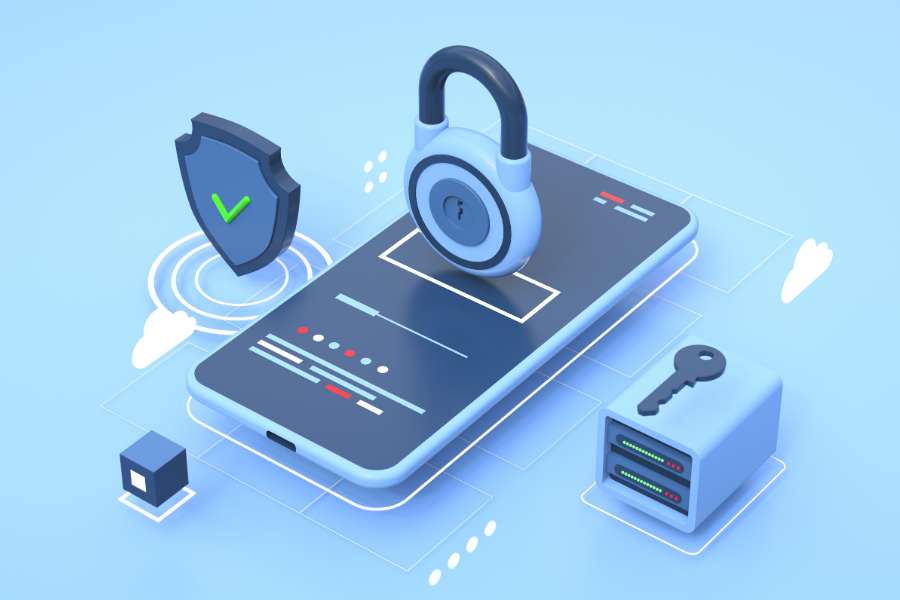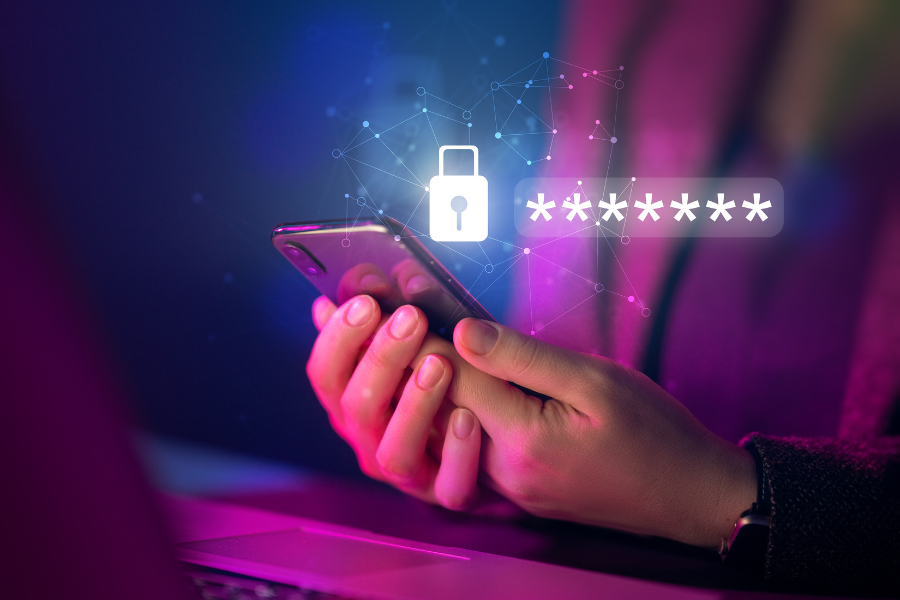HOT OFFER! Save $180 on selected internet plans + get beIN SPORTS CONNECT included!...Use promo code BEIN30 at checkout! Hurry, limited time only!
Mobile Security Tips: How to Secure Your Network & Device
Internet & Mobile Security Blog | MATE | 29 May 2024

In today’s digital landscape, ensuring the security of our mobile devices and networks has become more crucial than ever. With a myriad of potential risks and threats lurking in the online realm, it’s essential to arm ourselves with the knowledge and practices that will keep our personal information safe. So, let’s dive into some mobile security tips that will help you secure your network and device.
Understanding your mobile device
In order to effectively protect your device, it’s essential to understand its operating system and inherent security measures. Android phones, iOS devices, and other smartphones each have their unique nuances when it comes to mobile device security.
Android security
With the Android operating system being the most widely used worldwide, understanding its security landscape is paramount. Android’s open-source nature allows for greater customisability but also comes with certain risks. For instance, while the Google Play Store does have robust security measures in place, the freedom to install apps from third-party stores on Android devices increases the risk of downloading malicious apps.
However, this shouldn’t dampen your spirit as Android security is continually advancing with features like Google Play Protect and regular updates to combat mobile security threats. If used wisely, Android phones can offer a secure and flexible user experience.
iOS security
On the other hand, iOS operating systems maintain a walled garden approach to their app store, offering a curated list of apps that have passed stringent review processes. This limits the exposure of iPhones to malicious apps, enhancing the security of iOS devices.
That said, keeping the iOS software updated is equally important to benefit from Apple’s continuous efforts in fortifying iPhone security against emerging threats. Remember, no platform is entirely invulnerable, and mobile security best practices must be implemented regardless of your device’s operating system.
Protecting your mobile device
Protect your phone from physical access
While we often focus on cyber threats, it’s important not to overlook the risks of physical access. Never leave your mobile phone unattended in public places. Use features like an automatic lock to ensure your device locks itself after a period of inactivity. Physical security is a critical aspect of overall phone security that is often forgotten.
Keep your operating system up-to-date
You might have heard it before, but it’s worth repeating: keeping your operating system up-to-date is paramount. This is a basic yet vital practice to keep your devices secure. Regular software updates provide critical security patches that address vulnerabilities discovered over time.
These vulnerabilities are loopholes that hackers can exploit to gain access to your device. Software updates close these loopholes, making your device more secure. Make sure you know how to check for and install updates on your Android or iOS device to stay one step ahead of potential threats. Understanding the workings of your phone’s operating system, be it Android operating systems or iOS operating systems, is fundamental in ensuring its security.
Download apps safely
The app stores we use play a crucial role in ensuring the safety of the applications we install. Stick to trusted app stores such as the Google Play Store and Apple App Store to minimise the risk of downloading malicious apps. These platforms have rigorous review processes and security measures to weed out malicious apps, ensuring a safer environment for their users.
Before installing any app, take a moment to review its permissions carefully. Many apps ask for unnecessary permissions that may infringe on your privacy or expose your device to vulnerabilities. Denying these permissions can keep your device safer. Be cautious of apps or developers that raise suspicion. In the era of sophisticated mobile security threats, your vigilance can be a significant deterrent for hackers.
Secure your device with strong authentication
Your device’s security begins with strong authentication measures. Set a robust password, PIN, or pattern lock to prevent unauthorised access. Additionally, leverage the convenience of biometric authentication options like fingerprint or face recognition. For an extra layer of protection, consider enabling two-factor authentication for added peace of mind.
Using Antivirus software for mobile devices
Just like your computer, your mobile devices also benefit significantly from robust antivirus software. Antivirus applications can help protect your device from malware, viruses, phishing attacks, and other cyber threats. These applications often include features like regular automatic scans and real-time protection. They can identify and quarantine suspicious files, scan your installed apps for potential risks, and warn you of malicious websites while browsing.
However, it’s important to choose a reliable and highly-rated antivirus software, as not all are equally effective. Consider factors such as its detection rates, user reviews, impact on device performance, and its compatibility with your device’s operating system before making a selection.
Safeguard your network
Secure your home Wi-Fi network
While your home WiFi network might feel like a safe haven, it can become a potential entry point for cybercriminals if not properly secured. Protect it by changing the default network name (SSID) and password. Enable WPA2 or WPA3 encryption protocols to ensure secure connections. Additionally, disable remote administration and guest networks if they’re not necessary to minimise potential vulnerabilities. You can also try disabling UPnP (Universal Plug and Play) to prevent any unauthorised access to your router.
Exercise caution on public Wi-Fi networks
While public Wi-Fi networks can be convenient, they do come with some risk. Public WiFi networks lack the secure infrastructure of your home network, making them potential playgrounds for hackers. But don’t worry; it doesn’t mean you have to abstain from using public WiFi entirely. Just be cautious when accessing sensitive information, such as banking services, on public Wi-Fi. Consider using mobile data until you can connect to a secure WiFi network. However, if using public Wi-Fi is your only option, there are some best practices to ensure your mobile phone security.

Firstly, always verify the legitimacy of the network before connecting to avoid falling into potential traps set up by cybercriminals. These traps often take the form of “evil twin” networks, which imitate legitimate Wi-Fi hotspots to trick unsuspecting mobile users into connecting.
Secondly, make sure your device isn’t set to automatically connect to new Wi-Fi networks. This simple setting can prevent your device from inadvertently connecting to unsecured networks, giving you control over the networks you connect to.
By practising these mobile security tips, you can significantly reduce your risk when using public Wi-Fi networks and ensure a safer online experience.
Protect against phone scams
While the evolution of technology has brought countless conveniences to our fingertips, it has also given rise to sophisticated scams. Scammers are always finding new ways to exploit vulnerabilities and trick mobile users into falling for their schemes. Understanding these scams and how to identify them is a vital part of mobile phone security.
Phishing Scams
Phishing scams are one of the most prevalent threats to mobile users. These scams involve tricking the user into revealing sensitive information, such as passwords or credit card details. They often come in the form of deceptive emails or text messages that appear to be from trusted sources. Always be wary of unsolicited messages that ask for personal information or prompt you to click on a link.
Smishing Scams
Smishing is a form of phishing that specifically targets mobile users via SMS. The messages may include a link that, when clicked, installs malicious software on your device or leads to a fraudulent website. Avoid clicking on any links from unknown numbers and report such messages to your service provider.
Best practices for mobile security
Regularly backup your data
Data loss can occur due to various reasons, including device theft, hardware failure, or ransomware attacks. Regularly backing up your data is essential to protect your valuable information. This practice ensures that even in the worst-case scenario, your data isn’t permanently lost. Android and iOS devices offer backup options that can safeguard your data in the event of unforeseen circumstances.
These backup options include automatically saving your contacts, media, and app data to your respective Google or iCloud accounts. Be sure to enable them to maintain a continuous backup of your important data. Additionally, consider using third-party apps that offer extensive backup options. These apps often offer additional features, such as scheduled backups and encryption, to ensure your data’s safety. Remember to review your backup settings periodically and test your backups to verify their integrity.
Enable remote tracking and wiping
Misplacing or losing your mobile device can be a distressing experience. To mitigate the potential consequences, enable features like Find My Device (Android) or Find My iPhone (iOS). These functionalities allow you to track your device’s location and remotely wipe its data, ensuring that your personal information remains secure. Apart from these, there are several third-party apps available that provide advanced tracking and remote wiping features. They offer capabilities like taking a picture of the person attempting to unlock your phone, sounding an alarm, and more. However, remember to use these tools responsibly to respect others’ privacy. If your phone is stolen, it’s recommended to report it to law enforcement and let them handle the situation. In such a scenario, the ability to remotely wipe your device is a powerful tool. It can prevent your personal data from falling into the wrong hands, mitigating the potential damage from such incidents.
Educate yourself and stay informed
Knowledge is power when it comes to mobile security. Stay updated on the latest trends, news, and best practices in the realm of mobile security. This includes understanding the different types of threats, how they work, and how you can protect against them. Follow reputable sources, such as MATE internet + mobile, to access reliable information and expert tips. Also, consider joining trusted and dedicated forums for further information. They are a great source of practical advice and real-life experiences. By educating yourself, you empower yourself to make informed decisions that enhance your mobile security. In the ever-evolving world of cyber threats, your knowledge and awareness can be the most effective shield against potential attacks.
Final thoughts
The complexities of mobile security are far-reaching, spanning from understanding your device’s operating system to educating yourself about potential cyber threats. Yet, amidst the challenges, it’s reassuring to know that by taking the right precautions, we can create a robust shield to safeguard our mobile devices and networks. Whether you use an Android or iOS device, taking active steps to secure your network and device should not be an option but a necessity in this digital age.
By embracing a proactive approach to mobile security, we’re not just securing our devices and networks; we’re strengthening our stand against cyber threats. So, let’s take charge, stay informed, and empower ourselves to create a safer digital landscape.

